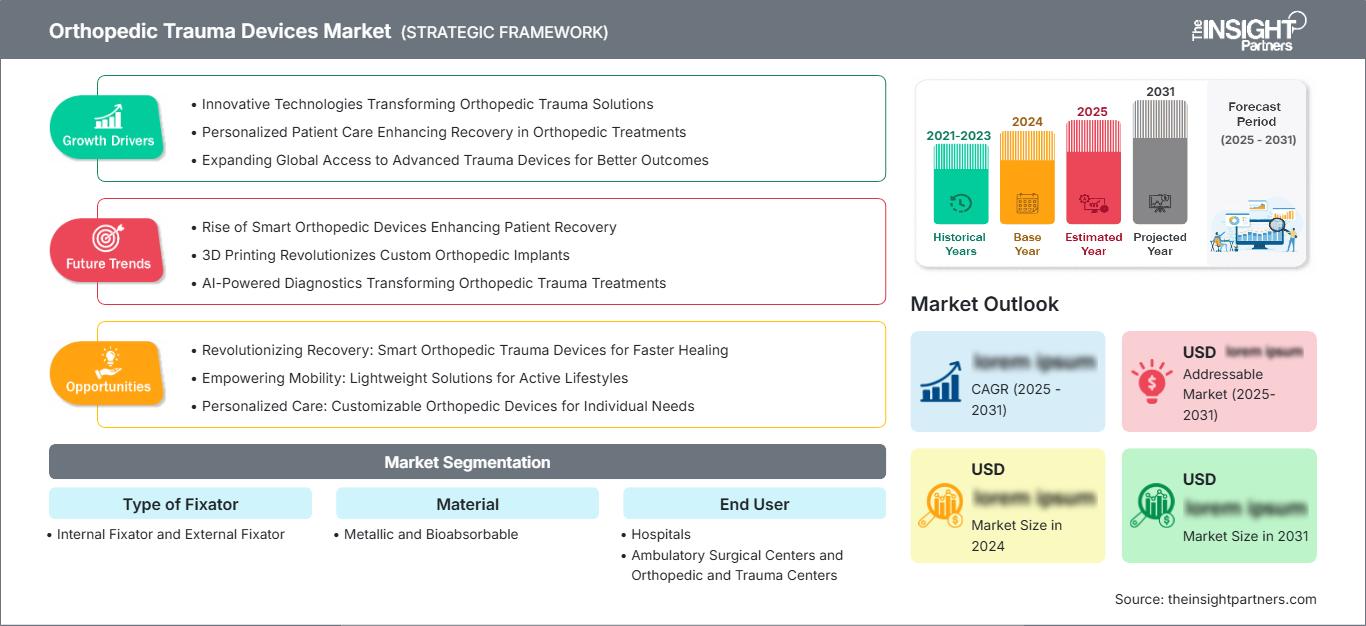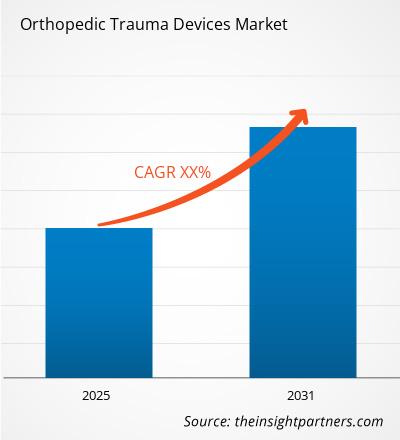Der Markt für orthopädische Traumaimplantate wird bis 2031 voraussichtlich ein Volumen von 17,44 Milliarden US-Dollar erreichen. Für den Zeitraum 2025–2031 wird ein jährliches Wachstum von 6,3 % erwartet.
Der Bericht ist nach Fixateur-Typ (interner und externer Fixateur) kategorisiert und analysiert den Markt zudem nach Material (metallisch und bioresorbierbar). Darüber hinaus wird der Markt nach Endnutzer (Krankenhäuser, ambulante Operationszentren sowie orthopädische und Traumazentren) untersucht. Für jedes dieser Schlüsselsegmente wird eine detaillierte Aufschlüsselung auf globaler, regionaler und Länderebene bereitgestellt. Der Bericht enthält Marktgrößen und Prognosen für alle Segmente, angegeben in US-Dollar. Der Bericht liefert zudem wichtige Statistiken zum aktuellen Marktstatus führender Akteure sowie Einblicke in vorherrschende Markttrends und neue Chancen.
Zweck des Berichts
Der Bericht „Markt für orthopädische Traumageräte“ von The Insight Partners beschreibt die aktuelle Marktlage und das zukünftige Wachstum, die wichtigsten Treiber, Herausforderungen und Chancen. Er bietet Einblicke für verschiedene Akteure im Markt, darunter:
- Technologieanbieter/Hersteller: Um die sich entwickelnde Marktdynamik zu verstehen und potenzielle Wachstumschancen zu erkennen, um fundierte strategische Entscheidungen treffen zu können.
- Investoren: Um eine umfassende Trendanalyse hinsichtlich Marktwachstumsrate, Finanzprognosen und Chancen entlang der Wertschöpfungskette durchzuführen.
- Regulierungsbehörden: Um Richtlinien zu regulieren und Aktivitäten auf dem Markt zu überwachen, mit dem Ziel, Missbrauch zu minimieren, das Vertrauen der Investoren zu wahren und die Integrität und Stabilität des Marktes zu gewährleisten. Marktsegmentierung für orthopädische Traumaimplantate: Fixateur-Typ
- Interner und externer Fixateur
Material
- Metallisch und bioresorbierbar
Endnutzer
- Krankenhäuser
- Ambulante Operationszentren und orthopädische Traumazentren
Passen Sie diesen Bericht Ihren Anforderungen anSie erhalten kostenlos Anpassungen an jedem Bericht, einschließlich Teilen dieses Berichts oder einer Analyse auf Länderebene, eines Excel-Datenpakets sowie tolle Angebote und Rabatte für Start-ups und Universitäten.
Markt für orthopädische Traumageräte: Strategische Einblicke

-
Holen Sie sich die wichtigsten Markttrends aus diesem Bericht.Dieses KOSTENLOSE Beispiel umfasst Datenanalysen, die von Markttrends bis hin zu Schätzungen und Prognosen reichen.
Wachstumstreiber des Marktes für orthopädische Traumageräte
- Innovative Technologien revolutionieren Lösungen für orthopädische Traumata
- Personalisierte Patientenversorgung verbessert die Genesung in der Orthopädie
- Ausweitung des globalen Zugangs zu fortschrittlichen Traumageräten für bessere Behandlungsergebnisse
Zukunftstrends des Marktes für orthopädische Traumageräte
- Aufstieg intelligenter orthopädischer Geräte verbessert die Genesung von Patienten
- 3D-Druck revolutioniert individuelle orthopädische Implantate
- KI-gestützte Diagnostik revolutioniert die Behandlung von orthopädischen Traumata
Marktchancen für orthopädische Traumageräte
- Revolutionäre Genesung: Intelligente orthopädische Traumageräte für eine schnellere Heilung
- Mehr Mobilität: Leichte Lösungen für einen aktiven Lebensstil
- Personalisierte Versorgung: Anpassbare orthopädische Hilfsmittel für individuelle Bedürfnisse
Markt für orthopädische Traumageräte
Die regionalen Trends und Einflussfaktoren auf den Markt für orthopädische Traumageräte im gesamten Prognosezeitraum wurden von den Analysten von The Insight Partners ausführlich erläutert. Dieser Abschnitt behandelt außerdem die Marktsegmente und die geografische Verteilung des Marktes für das Management von Herzrhythmusstörungen in Nordamerika, Europa, Asien-Pazifik, dem Nahen Osten und Afrika sowie Süd- und Mittelamerika.
Berichtsumfang zum Markt für orthopädische Traumageräte
By Material- metallisch und bioabsorbierbar
- Krankenhäuser
- ambulante chirurgische Zentren und orthopädische und Traumazentren
- Großbritannien
- Deutschland
- Frankreich
- Russland
- Italien
- Restliches Europa
- China
- Indien
- Japan
- Australien
- Restlicher Asien-Pazifik
- Brasilien
- Argentinien
- Restliches Süd- und Mittelamerika
- Südafrika
- Saudi-Arabien
- Vereinigte Arabische Emirate
- Restlicher Naher Osten und Afrika
Berichtsattribut Einzelheiten Marktgröße in 2024 US$ XX Billion Marktgröße nach 2031 US$ 17.44 Billion Globale CAGR (2025 - 2031) 6.3% Historische Daten 2021-2023 Prognosezeitraum 2025-2031 Abgedeckte Segmente By Art des Fixateurs - interner Fixateur und externer Fixateur
Abgedeckte Regionen und Länder Nordamerika - USA
- Kanada
- Mexiko
Marktführer und wichtige Unternehmensprofile - DePuy Synthes
- Stryker
- B. Braun Melsungen AG
- Arthrex, Inc.
- CONMED Corporation
- Smith & Nephew
- Orthofix Holdings, Inc.
- Zimmer Biomet
- Integra LifeSciences
Dichte der Marktteilnehmer im Bereich orthopädischer Traumageräte: Auswirkungen auf die Geschäftsdynamik
Der Markt für orthopädische Traumageräte wächst rasant, angetrieben durch die steigende Nachfrage der Endverbraucher. Gründe hierfür sind unter anderem sich wandelnde Verbraucherpräferenzen, technologische Fortschritte und ein wachsendes Bewusstsein für die Vorteile der Produkte. Mit steigender Nachfrage erweitern Unternehmen ihr Angebot, entwickeln innovative Lösungen, um den Kundenbedürfnissen gerecht zu werden, und nutzen neue Trends, was das Marktwachstum zusätzlich beflügelt.

- Holen Sie sich die Markt für orthopädische Traumageräte Übersicht der wichtigsten Akteure
Wichtigste Verkaufsargumente
- Umfassende Abdeckung: Der Bericht bietet eine umfassende Analyse der Produkte, Dienstleistungen, Typen und Endnutzer des Marktes für orthopädische Traumageräte und vermittelt so ein ganzheitliches Bild.
- Expertenanalyse: Der Bericht basiert auf dem fundierten Wissen von Branchenexperten und Analysten.
- Aktuelle Informationen: Der Bericht gewährleistet Geschäftsrelevanz durch die Berücksichtigung aktueller Informationen und Datentrends.
- Anpassungsmöglichkeiten: Dieser Bericht kann an spezifische Kundenanforderungen angepasst werden und sich optimal in die Geschäftsstrategien integrieren.
Der Forschungsbericht zum Markt für orthopädische Traumageräte kann somit maßgeblich dazu beitragen, das Branchenszenario und die Wachstumsaussichten zu entschlüsseln und zu verstehen. Auch wenn einige berechtigte Bedenken bestehen, überwiegen die Vorteile dieses Berichts insgesamt die Nachteile.
- Historische Analyse (2 Jahre), Basisjahr, Prognose (7 Jahre) mit CAGR
- PEST- und SWOT-Analyse
- Marktgröße Wert/Volumen – Global, Regional, Land
- Branchen- und Wettbewerbslandschaft
- Excel-Datensatz
Aktuelle Berichte
Erfahrungsberichte
Grund zum Kauf
- Fundierte Entscheidungsfindung
- Marktdynamik verstehen
- Wettbewerbsanalyse
- Kundeneinblicke
- Marktprognosen
- Risikominimierung
- Strategische Planung
- Investitionsbegründung
- Identifizierung neuer Märkte
- Verbesserung von Marketingstrategien
- Steigerung der Betriebseffizienz
- Anpassung an regulatorische Trends






















 Kostenlose Probe anfordern für - Markt für orthopädische Traumageräte
Kostenlose Probe anfordern für - Markt für orthopädische Traumageräte